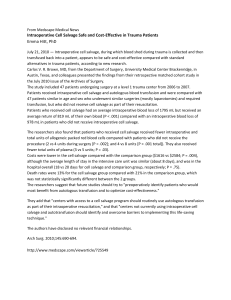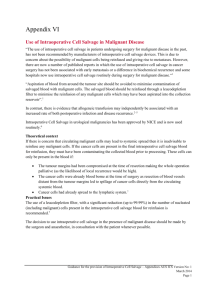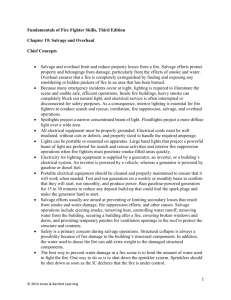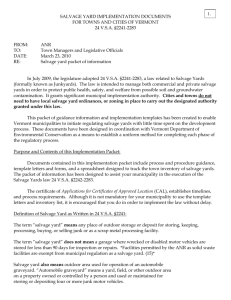Appendix V Intraoperative Cell Salvage
advertisement
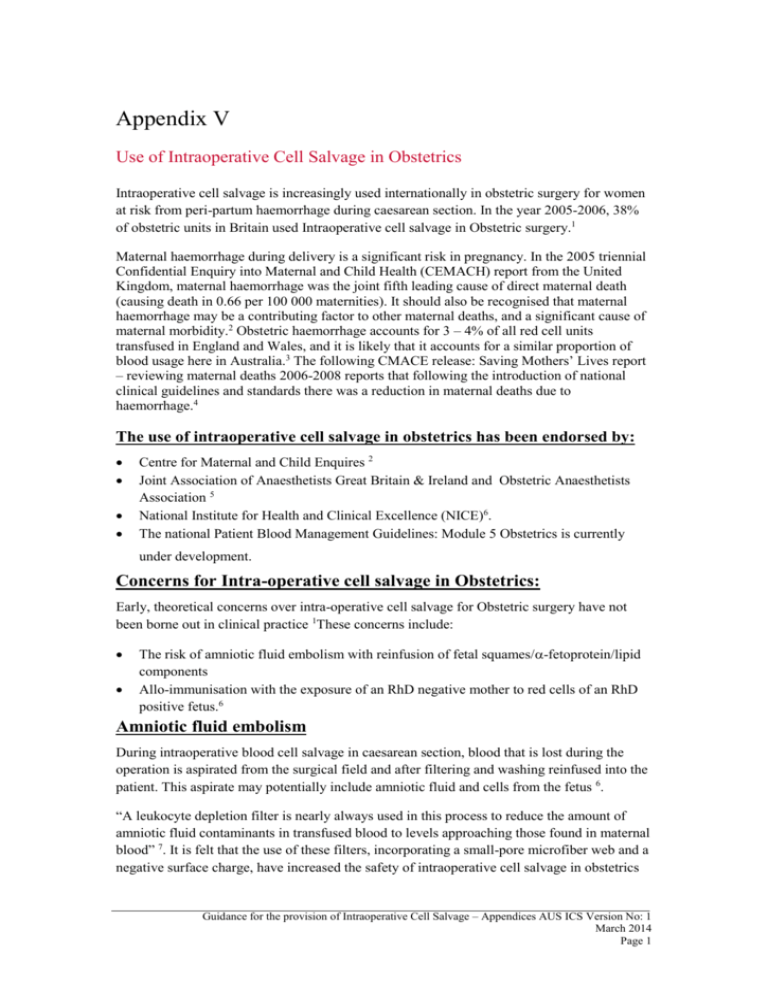
Appendix V Use of Intraoperative Cell Salvage in Obstetrics Intraoperative cell salvage is increasingly used internationally in obstetric surgery for women at risk from peri-partum haemorrhage during caesarean section. In the year 2005-2006, 38% of obstetric units in Britain used Intraoperative cell salvage in Obstetric surgery.1 Maternal haemorrhage during delivery is a significant risk in pregnancy. In the 2005 triennial Confidential Enquiry into Maternal and Child Health (CEMACH) report from the United Kingdom, maternal haemorrhage was the joint fifth leading cause of direct maternal death (causing death in 0.66 per 100 000 maternities). It should also be recognised that maternal haemorrhage may be a contributing factor to other maternal deaths, and a significant cause of maternal morbidity.2 Obstetric haemorrhage accounts for 3 – 4% of all red cell units transfused in England and Wales, and it is likely that it accounts for a similar proportion of blood usage here in Australia.3 The following CMACE release: Saving Mothers’ Lives report – reviewing maternal deaths 2006-2008 reports that following the introduction of national clinical guidelines and standards there was a reduction in maternal deaths due to haemorrhage.4 The use of intraoperative cell salvage in obstetrics has been endorsed by: Centre for Maternal and Child Enquires 2 Joint Association of Anaesthetists Great Britain & Ireland and Obstetric Anaesthetists Association 5 National Institute for Health and Clinical Excellence (NICE)6. The national Patient Blood Management Guidelines: Module 5 Obstetrics is currently under development. Concerns for Intra-operative cell salvage in Obstetrics: Early, theoretical concerns over intra-operative cell salvage for Obstetric surgery have not been borne out in clinical practice 1These concerns include: The risk of amniotic fluid embolism with reinfusion of fetal squames/-fetoprotein/lipid components Allo-immunisation with the exposure of an RhD negative mother to red cells of an RhD positive fetus.6 Amniotic fluid embolism During intraoperative blood cell salvage in caesarean section, blood that is lost during the operation is aspirated from the surgical field and after filtering and washing reinfused into the patient. This aspirate may potentially include amniotic fluid and cells from the fetus 6. “A leukocyte depletion filter is nearly always used in this process to reduce the amount of amniotic fluid contaminants in transfused blood to levels approaching those found in maternal blood” 7. It is felt that the use of these filters, incorporating a small-pore microfiber web and a negative surface charge, have increased the safety of intraoperative cell salvage in obstetrics Guidance for the provision of Intraoperative Cell Salvage – Appendices AUS ICS Version No: 1 March 2014 Page 1 by removing the particulate contaminants felt responsible for amniotic fluid embolism associated with disseminated intravascular clotting (DIC). 8,9 Leukocyte depletion filters remove products such as fetal squamous cells, lipids, amniotic fluid and vernix to produce levels either lower than or similar to those seen in maternal central blood samples at the time of uteroplacental separation 10. Studies on post wash samples have found that the factors which are postulated to cause amniotic fluid embolism syndrome (e.g. α- fetoprotein, trophoblasts, lanugo hair, vernix caseosa and tissue factor) can be completely eliminated by using a leucodepletion filter.8 The use of two separate suction devices for amniotic fluid (initially) and blood (after delivery) is still common practise. Based on the amount of evidence available at this time this practise is still recommended, even though a single suction device has been used in case reports around the world. “Amniotic fluid should theoretically not be aspirated into the collection reservoir, but should be removed by separate suction prior to starting cell salvage. This recommendation will reduce the initial contamination, although in vitro evidence consistently demonstrates that the cell salvage/filtration process can effectively remove amniotic fluid contaminants whatever the initial load. 6,7 . In life-threatening haemorrhage, therefore, a clinical decision to salvage red cells from the start of the procedure could be carefully considered, and is supported by current in vitro evidence.” 1 “A randomised trial performed in 2008 compared the use of one suction device only (aspiration of all fluid into the ICS system) versus two suction devices. The trial demonstrated that following the washing and filtering processing, using a leucodepletion filter, the level of residual amniotic fluid contamination was no different 11 This study conducted in 34 patients over a 4 month period does provide some evidence of the potential safety of using one sucker device in combination with a leucodepletion filter, in relation to the presence of some fetal products believed to be involved in the “amniotic fluid embolism” syndrome. However more evidence would be necessary before recommendation could be provided to change towards the use of one suction device in standard practise. It is important to recognise that, although cell salvage in combination with leucodepletion filters can eliminate amniotic fluid components, it will not prevent foetal red cells being transfused as the cell salvage system is unable to differentiate between maternal and foetal red cells. Reinfusion of salvaged blood containing foetal red cells may result in maternal alloimmunisation if there is an antigen incompatibility between maternal and foetal red cells. However, this risk is not considered to be any greater than that occurring at normal vaginal delivery15 Rh immunisation and Kleihauer testing Feto-maternal haemorrhage (FMH) may occur at any stage of pregnancy and delivery in RhD negative mothers with RhD positive fetuses, if the maternal circulation is exposed to fetal red cells. Antibodies against the fetal red cells can cause haemolytic disease of the newborn in subsequent pregnancies if untreated. Consequently all Rh negative mothers of Rh positive babies should have Kleihauer testing performed to assess if there has been a significant FMH after any at risk event during pregnancy or following delivery. Guidance for the provision of Intraoperative Cell Salvage – Appendices AUS ICS Version No: 1 March 2014 Page 2 Anti D immunoglobulin is given to prevent alloimmunisation from Rh positive red cells, with the dose given dependent upon the volume of red cells detected in the maternal circulation via the Kleihauer test. Testing for FMH should occur following the use of Intra-operative cell salvage particularly as an increased number of fetal red cells may have been reinfused during the cell salvage procedure. It is possible that a higher degree of fetal red cell exposure could occur requiring a higher dose of anti-D to be administered. A similar procedure is followed antenatally when incidents occur known to be associated with alloimmunization.”12 The local policy for the management of Rh negative mothers who delivered should be followed for those who have undergone reinfusion of intraoperative cell salvage blood. The presence of fetal red cells in the intraoperative cell salvage blood is likely because the intraoperative cell salvage device cannot distinguish fetal from maternal red cells. The sample for Kleihauer testing should be taken after the reinfusion of intraoperative cell salvage blood and administration of Anti-D should occur as soon as possible, within 48-72 hrs of delivery for successful immunoprophylaxis.13 In summary maternal alloimmunisation is a potential risk and therefore presents a risk of future haemolytic disease of the newborn, however this can be minimised by appropriate use of anti-D in consultation with the Obstetrician responsible for the care of the patient. Caution should be taken when Jehovah’s Witness patients have a concern with receiving anti-D immunoglobulin. Refer to local protocol regarding testing for and management of FMH. Guidelines for FMH testing have also been developed by the Australian and New Zealand Society of Blood Transfusion : www.anzsbt.org.au Rebarber14 reported the first triple-centre historical cohort study, comparing 139 patients who received cell salvaged blood during caesarean section to a group receiving allogeneic blood. There was no difference between the two groups which could be accounted to complications secondary to cell salvage 15 According to the National Institute for Health and Clinical Excellence (NICE): “NICE considered the evidence relating to the efficacy and safety of intraoperative blood cell salvage in obstetrics in response to concerns expressed about theoretical risks associated with the procedure. These concerns were the possibility of amniotic fluid embolism and haemolytic disease in future pregnancies, when used in obstetrics. The evidence relating to safety of cell salvage in these procedures was considered adequate and therefore NICE does not intend to review its use in other specific clinical situations unless notified of new indications for intraoperative cell salvage in which there may be new safety concerns” 6 Patient Selection Wherever possible, the advantages and risks of intraoperative cell salvage and allogeneic blood transfusion should be discussed with the patient prior to undergoing an obstetric surgical procedure and clearly documented. In an elective case this can usually be done during the pregnancy. Indications for Intraoperative Cell Salvage Patient selection for intraoperative cell salvage in obstetric surgery is at the discretion of the Obstetrician and Anaesthetist caring for the patient. Guidance for the provision of Intraoperative Cell Salvage – Appendices AUS ICS Version No: 1 March 2014 Page 3 The type of obstetric cases that could be considered for selection includes: Emergency situations: 1. Ruptured ectopic pregnancy. 2. Post-partum haemorrhage. 3. Return to theatre after caesarean section. Elective situations: 1. Patients with an anticipated blood loss of >20% estimated blood volume. 2. Placenta accreta, Placenta increta and Placenta percreta. 3. Large uterine fibroids. Other situations: 1. Patients who for religious or other reasons refuse allogeneic blood and have consented to the use of intraoperative cell salvage in elective or emergency procedures. 2. Significant anaemia or coagulopathy. Cell Salvage of Vaginal Bleeding The use of cell salvage during vaginal haemorrhage is currently under investigation. There is a theoretical concern that blood salvaged from the vagina peri-partum may be contaminated with bacteria. However, there have been case reports where this practise was used without obvious adverse outcome. The benefit of this procedure should be weighed against the potential risk on a case by case basis by the clinician responsible for the patient. This practise may be considered for life threatening haemorrhage, for example where the patient refuses the use of allogeneic blood products. Thorough saline irrigation, the use of a leukocyte depletion filter and antibiotic prophylaxis would be recommended in this situation. Caution concerning the use of Leukocyte depletion filters (LDF): Proper training practices and the recommendations from the specific manufacturer should be adhered to when using leukocyte depletion filters. Consider the following issues: o Some filters may require special priming prior to use. o Their effectiveness may become diminished as more units of blood are transfused through a single filter. o The effectiveness of some of these filters is also diminished as a result of the increasing infusion rate through the filter (some filters have a maximum recommended infusion rate). o Leukocyte depletion filters may lead to an increase in haemolysis. o These filters are also more prone to occlusion than other filters. In summary The evidence for the safety of intraoperative cell salvage is favourable and the early theoretical concerns have not been seen in clinical practice to date. Guidance for the provision of Intraoperative Cell Salvage – Appendices AUS ICS Version No: 1 March 2014 Page 4 References 1. UK Cell Salvage Action Group. ICS Technical Factsheet. 2008; 2. CEMACH. Saving Mothers’ Lives 2003-2005 (Executive Summary). Confidential Enquiries into Maternal Deaths in the United Kingdom. 2007;7(December):1–12. 3. Catling S. Blood conservation techniques in obstetrics: a UK perspective. International journal of obstetric anesthesia [Internet]. 2007;16(3):241–9. Available from: http://www.ncbi.nlm.nih.gov/pubmed/17509870 4. CMACE. Saving Mothers’ Lives Reviewing maternal deaths to make motherhood safer: 2006–2008. 2011; 5. AAGBI/OAA The Association of Anaesthetists of Great Britain and Ireland Obstetric Anaesthetists’ Association Guidelines. Guidelines for Obstetric Anaesthetic Services Revised Edition, 25. 2005; Available from: http://www.aagbi.org/sites/default/files/obstetric05.pdf 6. National Institute for Health and Clinical Excellence(NICE). Guideline IPG144: Intraoperative blood cell salvage in Obstetrics. 2005 [Internet]. Available from: http://publications.nice.org.uk/intraoperative-blood-cell-salvage-in-obstetrics-ipg144 7. UK Cell Salvage Action Group. Use of Filters in ICS. 2012; Available from: http://www.transfusionguidelines.org.uk/docs/pdfs/bbt-03_icsag-fs-07_0807-v2.pdf 8. Waters JH, Biscotti C, Potter PS, Phillipson E. Amniotic fluid removal during cell salvage in the cesarean section patient. Anesthesiology [Internet]. 2000;92(6):1531–6. Available from: http://www.ncbi.nlm.nih.gov/pubmed/10839901 9. Dzik. Leukodepletion blood filters: filter design and mechanisms of leukocyte removal. Transfusion medicine reviews. 1993; 10. Thornhill ML, O'Leary AJ, Lussos SA, Rutherford C. AN IN-VITRO ASSESSMENT OF AMNIOTIC FLUID REMOVAL FROM HUMAN BLOOD THROUGH CELL SAVER PROCESSING. Anesthesiology [Internet]. 1991;75(Supplement):A830. Available from: http://content.wkhealth.com/linkback/openurl?sid=WKPTLP:landingpage&an=00000 542-199109001-00829 11. Sullivan, I., Faulds, J., & Ralph C. Contamination of salvaged maternal blood by amniotic fluid and fetal red cells during elective Caesarean section. British Journal of Anaesthesia. 2008;101(2):225–9. 12. Bromilow IM, Duguid JK. Measurement of feto-maternal haemorrhage: a comparative study of three Kleihauer techniques and tow flow cytometry methods. Clinical and laboratory haematology [Internet]. 1997;19(2):137–42. Available from: http://www.ncbi.nlm.nih.gov/pubmed/9218154 Guidance for the provision of Intraoperative Cell Salvage – Appendices AUS ICS Version No: 1 March 2014 Page 5 13. Australian Red Cross Blood Service. Guidelines for the use of Rh(D) immunoglobulin in pregnant women with Rh(D)-negative blood group, and no pre-existing Anti-D antibodies. 2012 [Internet]. Available from: http://www.transfusion.com.au/disease_therapeutics/pregnancy/guidelines-RhD-Ig 14. Rebarber A, Lonser R, Jackson S, Copel JA, Sipes S. The safety of intraoperative autologous blood collection and autotransfusion during cesarean section. American journal of obstetrics and gynecology [Internet]. 1998;179(3 Pt 1):715–20. Available from: http://www.ncbi.nlm.nih.gov/pubmed/9757977 15. Bernstein HH, Rosenblatt MA, Gettes M, Lockwood C. The ability of the Haemonetics 4 Cell Saver System to remove tissue factor from blood contaminated with amniotic fluid. Anesthesia and analgesia [Internet]. 1997;85(4):831–3. Available from: http://www.ncbi.nlm.nih.gov/pubmed/9322464 Guidance for the provision of Intraoperative Cell Salvage – Appendices AUS ICS Version No: 1 March 2014 Page 6

